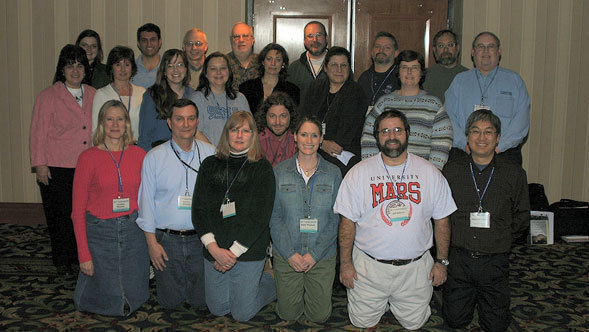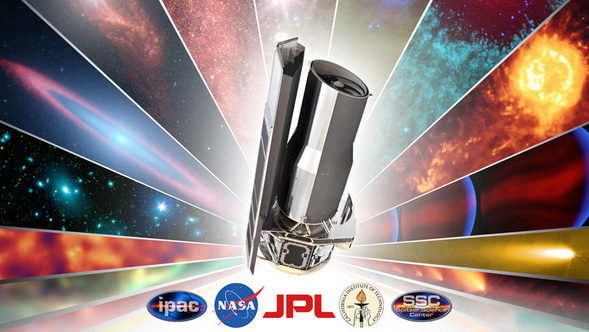
By Luisa Rebull | September 30th, 2009
I'm Luisa, an astronomer here at Spitzer. I study baby stars which will grow up to be like our Sun. But more about that in another posting...
Among many other roles, I am also the director of a program called NITARP, the NASA/IPAC Teacher Archive Research Program, and we just today finished selecting our new teachers for 2010! I am very excited about this! NITARP is one way in which we get authentic research experiences ultimately into classrooms across the United States. We partner scientists with (primarily) high school teachers, do a research project, and present the results at a professional astronomy meeting; the teachers incorporate the experience into their classroom and share their experience with other teachers.
The Spitzer Science Center (SSC) and the NASA Infrared Processing and Analysis Center (IPAC) (with help from the National Optical Astronomy Observatory (NOAO)) are leading this program. We select teachers from a nation-wide selection process. We use archival data from the Spitzer Space Telescope, the NASA/IPAC Extragalactic Database (NED), the NASA/IPAC/NExScI Star and Exoplanet Database (NStED), the NASA/IPAC Infrared Science Archive (IRSA) and other NASA archive holdings. Our funding comes from the Spitzer archive and the other archives at IPAC.
This program is incredibly rewarding for me personally. I have been with the program since its inception (see below) and I have had two different teams. We have looked for -- and found -- baby stars in several different regions. I find it to be a lot of fun to work with the teachers specifically because I learn from them how to be a better teacher just as they learn from me about the latest in astronomy (and more indirectly, computers and technology). Many people doing astronomy outreach work directly with students, and yes, it's great to change a kid's life. But if you change a teacher's life, you impact all the kids that that teacher reaches this year, and next year, and the year after that. It is really hard to beat that multiplicative effect!! Since there are probably only about 8-10,000 professional astronomers in the US, we can't reach everyone -- we have to do something to multiply our efforts.
Real research is totally unlike science as it is portrayed in textbooks, and that's an important lesson for the people involved in this project. By the time it makes it into textbooks, often science is portrayed as a never-ending series of right answers. Real science has a lot of dead ends as we struggle to find out what the 'right answer' is. Science problems in textbooks have well-defined problems, specific methods you're supposed to use to solve them, and right (exact) answers -- for example, 1.2 can be wrong when 1.3 is right. Real science is not quite "made up as you go along" but it may feel that way. Different people approach the same problem in different ways and many answers can all be right (1.2 and 1.3 can both be right answers). The only way you know it's the right answer is if you know that everything you did to get there is right. That's a big paradigm shift in thinking from "textbook science." And that's one big thing that I hope that the participants in this program learn.
There are lots of little lessons along the way too. Many of the students involved in the program note that they learned that "astronomers are normal, friendly people." One student was disappointed that the software she was using (which was the real software that professional astronomers use) did not tell her everything about a star when she clicked on it. The software she was used to using was software for amateur asronomers that goes out on the internet to find related information about the object, and most amateurs click on famous objects. That click-to-learn-more feature doesn't exist in the professional astronomy software she was using. But the really big lesson was that she was among the first people on our planet to care about that individual star, so she already knew all that all of humanity already knew about that object.
The original incarnation of this program was started in 2004 and called the Spitzer Space Telescope Research Program for Teachers and Students. Leveraging on a well-established teacher professional development program, the SSC offered this program to teachers in the Teacher Leaders in Research Based Science Education (TLRBSE), an ongoing program at the NOAO. This NSF-sponsored program touches the formal education community through a national audience of well-trained and supported middle and high school teachers. We had three rounds of teacher selection and research projects. Starting in 2009, we got new funding and a new name (NASA/IPAC Teacher Archive Research Project -- NITARP).
New this year, not only are we expanding the teacher side of the program to include community college professors, but also we are expanding on the IPAC and JPL side to include some of the non-astronomer professionals working here. This will bring new skills and insight and role models to the teams.
One of the teams in the original program started a wiki where we could share all sorts of materials we developed. The next generation NITARP project has inherited this wiki and will continue to develop it. Even if you are not part of this program, you can check out the resources on the wiki and learn how to play with Spitzer data (and eventually other archive data) yourself!
The teachers participating in the original program were: Jeff Adkins, John Blackwell, Kareen Borders, Howard T. Chun, Lauren K. Chapple, Harlan V. Devore, Velvet Dowdy, Cris DeWolf, Peter Guastella, Rosa Hemphill, Ardis Herrold, Chelen H. Johnson, Virginia Jones, Susan Kelly, Thomas Loughran, Anthony R. Maranto, Chris Martin, David W. McDonald, Jeff Paradis, Vincent Pereira, Peter Pitman, Steve Rapp, Theresa Roelofsen, John Schaefers, Babs Sepulveda, Linda Stefaniak, Timothy S. Spuck, Dwight Taylor, Jen Tetler, Beth Thomas, Cynthia Weehler and Lynne Zielinski. Here is a page with all of their accomplishments as part of this program. Support scientists included: Ranga-Ram Chary, Vandana Desai, John Feldmeier, Rose Finn, Varoujan Gorjian, Don Hoard, Steve Howell, Mark Lacy, Luisa M. Rebull, and Gregory Rudnick.
And finally, here for the first time ever, is the brand-new list of teachers to start with the program in January 2010! They are high school teachers, middle school teachers, and community college professors. They are from big cities and small towns. They will study nearby things and far away things. Look for results of their projects in January 2011!!
- Team working with Luisa Rebull (SSC)
- Chelen Johnson (Breck School, Minneapolis, MN) teacher mentor for team
- Kevin McCarron (Oak Park and River Forest High School, Oak Park, IL)
- Vivian Hoette (Yerkes Observatory, Williams Bay, WI)
- Carolyn Mallory (Pierce College, Woodland Hills, CA)
- Team working with Varoujan Gorjian (SSC/JPL)
- Tim Spuck (Oil City Regional Senior High School, Oil City, PA) teacher mentor for team
- Kate Meredith (LaCrosse area schools, LaCrosse, WI)
- Helen Petach (Fairview High School, Boulder, CO)
- Elizabeth Ramseyer (Niles West High School, Skokie, IL)
- Team working with Steve Howell (NOAO)
- Sally Seebode (San Mateo High School, San Mateo, CA) teacher mentor for team
- Darryl Stanford (San Mateo Community College, San Mateo, CA)
- Dean Drumheller (San Mateo Community College, San Mateo, CA)
- Second team working with Steve Howell (NOAO)
- Beth Thomas (North Middle School, Great Falls, MT) teacher mentor for team
- Richard DeCoster (Niles West High School, Skokie, IL)
- Peggy Piper (Lincoln-Way North High School, Frankfort, IL)
 Rocking with "Reionization to Exoplanets"
Rocking with "Reionization to Exoplanets"



